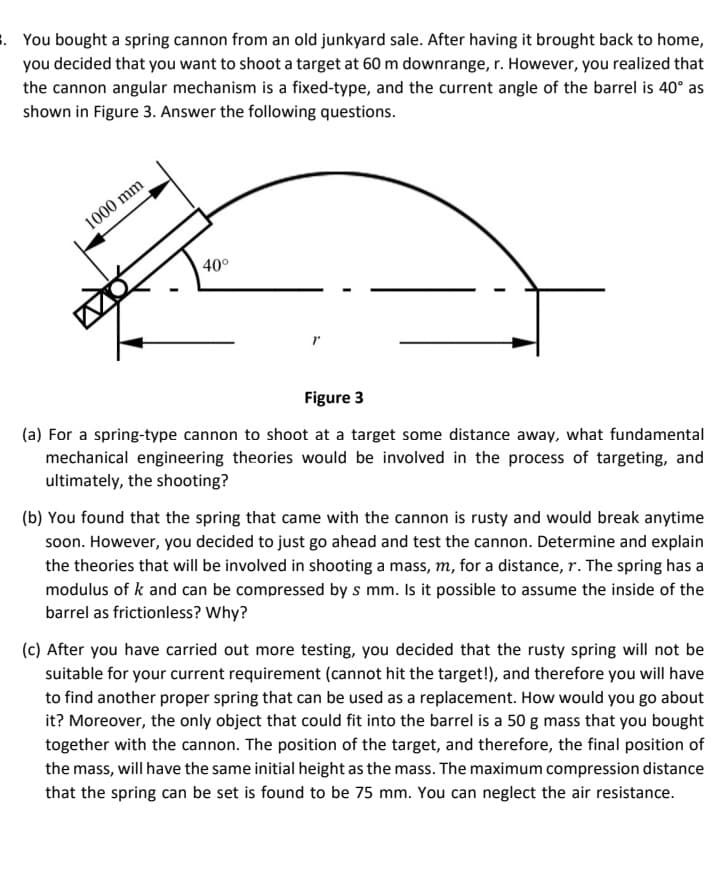You bought a spring cannon from an old junkyard sale. After having it brought back to home, you decided that you want to shoot a target at 60 m downrange, r. However, you realized that. the cannon angular mechanism is a fixed-type, and the current angle of the barrel is 40° as shown in Figure 3. Answer the following questions. 1000 mm 40° Figure 3 (a) For a spring-type cannon to shoot at a target some distance away, what fundamental mechanical engineering theories would be involved in the process of targeting, and ultimately, the shooting? (b) You found that the spring that came with the cannon is rusty and would break anytime. soon. However, you decided to just go ahead and test the cannon. Determine and explain the theories that will be involved in shooting a mass, m, for a distance, r. The spring has a modulus of k and can be compressed by s mm. Is it possible to assume the inside of the barrel as frictionless? Why? (c) After you have carried out more testing, you decided that the rusty spring will not be suitable for your current requirement (cannot hit the target!), and therefore you will have to find another proper spring that can be used as a replacement. How would you go about it? Moreover, the only object that could fit into the barrel is a 50 g mass that you bought. together with the cannon. The position of the target, and therefore, the final position of the mass, will have the same initial height as the mass. The maximum compression distance. that the spring can be set is found to be 75 mm. You can neglect the air resistance.
You bought a spring cannon from an old junkyard sale. After having it brought back to home, you decided that you want to shoot a target at 60 m downrange, r. However, you realized that. the cannon angular mechanism is a fixed-type, and the current angle of the barrel is 40° as shown in Figure 3. Answer the following questions. 1000 mm 40° Figure 3 (a) For a spring-type cannon to shoot at a target some distance away, what fundamental mechanical engineering theories would be involved in the process of targeting, and ultimately, the shooting? (b) You found that the spring that came with the cannon is rusty and would break anytime. soon. However, you decided to just go ahead and test the cannon. Determine and explain the theories that will be involved in shooting a mass, m, for a distance, r. The spring has a modulus of k and can be compressed by s mm. Is it possible to assume the inside of the barrel as frictionless? Why? (c) After you have carried out more testing, you decided that the rusty spring will not be suitable for your current requirement (cannot hit the target!), and therefore you will have to find another proper spring that can be used as a replacement. How would you go about it? Moreover, the only object that could fit into the barrel is a 50 g mass that you bought. together with the cannon. The position of the target, and therefore, the final position of the mass, will have the same initial height as the mass. The maximum compression distance. that the spring can be set is found to be 75 mm. You can neglect the air resistance.
Related questions
Question

Transcribed Image Text:3. You bought a spring cannon from an old junkyard sale. After having it brought back to home,
you decided that you want to shoot a target at 60 m downrange, r. However, you realized that
the cannon angular mechanism is a fixed-type, and the current angle of the barrel is 40° as
shown in Figure 3. Answer the following questions.
1000 mm
40°
Figure 3
(a) For a spring-type cannon to shoot at a target some distance away, what fundamental
mechanical engineering theories would be involved in the process of targeting, and
ultimately, the shooting?
(b) You found that the spring that came with the cannon is rusty and would break anytime
soon. However, you decided to just go ahead and test the cannon. Determine and explain
the theories that will be involved in shooting a mass, m, for a distance, r. The spring has a
modulus of k and can be compressed by s mm. Is it possible to assume the inside of the
barrel as frictionless? Why?
(c) After you have carried out more testing, you decided that the rusty spring will not be
suitable for your current requirement (cannot hit the target!), and therefore you will have
to find another proper spring that can be used as a replacement. How would you go about
it? Moreover, the only object that could fit into the barrel is a 50 g mass that you bought
together with the cannon. The position of the target, and therefore, the final position of
the mass, will have the same initial height as the mass. The maximum compression distance
that the spring can be set is found to be 75 mm. You can neglect the air resistance.
Expert Solution
This question has been solved!
Explore an expertly crafted, step-by-step solution for a thorough understanding of key concepts.
Step by step
Solved in 4 steps with 1 images
